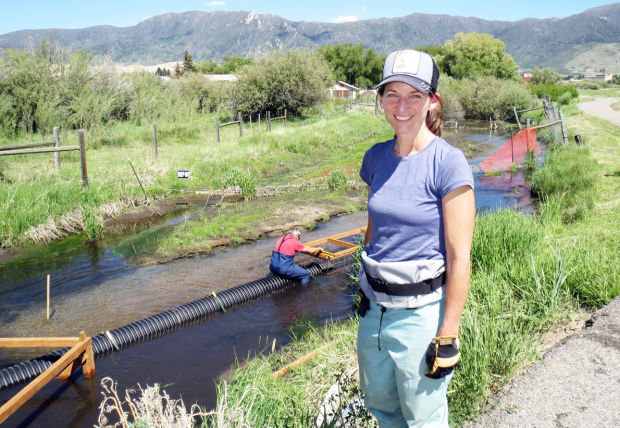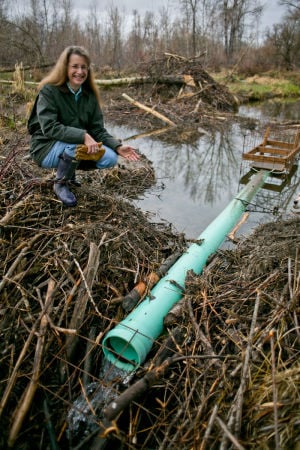This has been a strange week. It all began when I was approached by Tim Robinson, the senior resource scientist at Cachuma Operation and Maintenance Board in Santa Barbara. He wanted to know if I was interested in presenting in a workshop on steelhead and beavers for next year’s Salmonid Restoration Federation Conference.
 What is a salmonid? For beginners like us it’s a member of the salmon family, including salmon, trout and white fish. (Steelhead is rainbow trout that made it to sea and was changed by the experience.) The conference draws some 800 people from around the state, and last year the keynote was given by the new head of Fish and
What is a salmonid? For beginners like us it’s a member of the salmon family, including salmon, trout and white fish. (Steelhead is rainbow trout that made it to sea and was changed by the experience.) The conference draws some 800 people from around the state, and last year the keynote was given by the new head of Fish and Game Wildlife. It is a big deal because there are a lot of dollar interests in the health of our salmonid population.
Very quickly I talked myself out of saying yes. What do I know about steelhead? Santa Barbara is 5 hours away and that would mean I need to pay for the trip and the hotel. And I would be talking beavers to people that weren’t really there to talk about beavers. I asked all the voices of Worth A Dam who all thought it was a good investment, and I laid awake at night thinking wistfully that last year’s SRF conference was in Davis and why didn’t he ask me then?
I must have worried myself into a cold, because both Jon and I woke up with the mother of all illnesses. But I did decide I should go. And that the salmonid audience was the best place to preach the beaver gospel right now. I talked to Tim and found out that the workshop would be full of friends, Wikipedia Rick presenting our research on coastal beavers, Michael Pollock on steelhead in beaver ponds, Brock Dolman and Kate Lundquist on Beavers in the North coast. So I was a little comforted, but still dazed, as I pounded out my abstract.
Abstract
In 2007 the city of Martinez was prevented from responding to a problematic dam in Alhambra creek using trapping. Public pressure forced the city to try instead the installation of a flow device which successfully controlled flooding and allowed the beavers to remain. The subsequent wetlands created drew a succession of at least 15 new species to date, increased the range of rare and shy animals to make them more observable, allowed close observation of beaver behavior with opportunities for broad field education and encouraged civic participation through ecological awareness. The effects of beaver-assisted creek restoration in an urban setting and the role of citizen science are discussed.The effects of beaver-assisted creek restoration in an urban setting and the role of citizen science are discussed.
With my cold well on its way I cancelled work and tried to remember that the conference wasn’t until March and I would worry about that when we were closer to it. It’s probably just as well I had no voice at all when I got an email from A.L.Riley, the author of the most famous book on creek restoration and someone with interest in Worth A Dam and our beavers because of a very close mutual friend. She was putting together a workshop on restoring urban creeks for the salmonid restoration conference and would I be interested in talking about the restoration our beavers did in Martinez?
Abstract # 2:
In 2007 beavers dammed Alhambra creek in Martinez California, potentially harming roadways and prompting the city to recommend trapping. A dramatic resident response spurred media attention which forced city officials to find another way to solve the problem. Expert Skip Lisle was flown in from Vermont to install a flow device at the dam site which lowered the dam permanently and prevented flooding. The beavers responded to the water loss with a series of smaller secondary dams which expanded and enriched the wetlands, drawing new wildlife to the creek including otter and mink. The group “Worth A Dam” was formed to advocate for the beavers and educate the public about their role in creek restoration. Community events and a yearly beaver festival have been celebrated since that time, and Worth A Dam has assisted other cities in learning how and why to live with beavers. The effects of beaver-assisted creek restoration in an urban setting and the role of citizen science are discussed.
So now I’m at the tail end of a monstrous cold and committed to presenting twice at SRF in March. It is starting to feel like the right thing for me to do, but honestly I’m more than a little hesitant. Beaver voices are hairdressers and teachers and construction workers and authors. There are hydrologists and scientists in the club too but we are a mixed bag to be honest. Fish people are all biologists. They are steeped in science.
Well at the moment the science is telling them to think about beavers: And that means Heidi gets to talk at their conference. But you can bet I’m going to be doing a lot of reading between now and then.





 I’m not sure there’s a lot of merit to what he’s saying, at least for western landscapes, especially in mountainous terrain. I could see in some wide valleys where beaver have been removed, conifers are encroaching, and the area hasn’t already been cleared for development, that beavers could make a difference, but any effects from more beaver would probably be pretty localized, and in large fires that isn’t enough. A burning ember can travel up to a mile, they say. One could even make the case that increased humidity may increase growth of trees
I’m not sure there’s a lot of merit to what he’s saying, at least for western landscapes, especially in mountainous terrain. I could see in some wide valleys where beaver have been removed, conifers are encroaching, and the area hasn’t already been cleared for development, that beavers could make a difference, but any effects from more beaver would probably be pretty localized, and in large fires that isn’t enough. A burning ember can travel up to a mile, they say. One could even make the case that increased humidity may increase growth of trees 








































